You can spot up to 18 turtle species in New Jersey. There are 13 types that live in Jersey’s waters and the forests, while 5 sea turtles occasionally come to visit the waters on the coast. There are species such as the tiny Bog turtle, the medium sized Red Belly Cooter, and the very large Common Snapping turtle.
Here we describe all the species and offer distinguishing characteristics, the habitat they live in, and what kinds of things they eat. It’s great information if you are planning on exploring the state and looking for these turtles as a herping guide, or if you’re planning on purchasing one of these turtles as a pet.
Maybe you just want to know about the wildlife in the Garden State. Here is a great start, as you’ll become familiar with all the turtle species here.
Just know that you can’t purchase turtles in New Jersey. You can own pet turtles, but some will require a permit, and you’ll have to get them shipped in or travel across state lines. It’s illegal to sell turtles in the state of New Jersey, and you aren’t allowed to take them from the wild, except Common Snapping turtles.
With all that out of the way, let’s dive in and find out about all the turtles found in New Jersey.
Table of Contents
Turtles in New Jersey
1. Bog Turtle
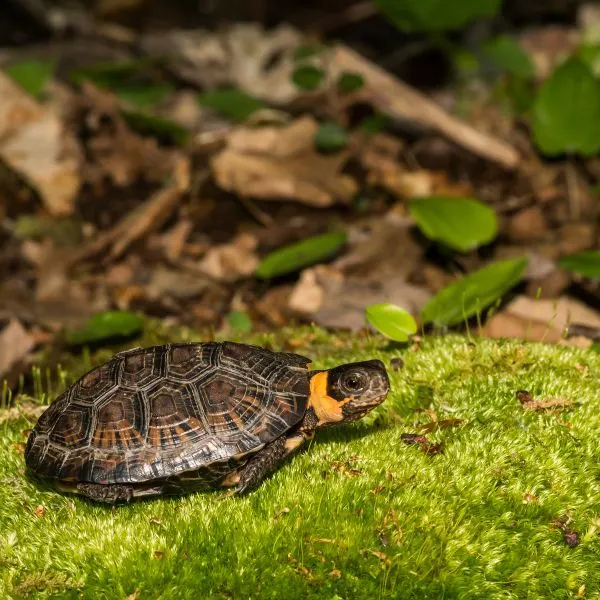
- Experience Level: *Expert
- Family: Emydidae
- Scientific Name: Glyptemys muhlenbergii
- Other Names: Muhlenberg’s turtle
- Adult Size: 3.5 to 5 inches (9 to 12.5 cm)
- Life Span: Up to 60 years in the wild
- Average Price Range: Illegal to own, Federally protected species
- Conservation Status: Endangered
Not only are Bog turtles the state reptile of New Jersey, but they are also the smallest turtle species in North America. These turtles are federally protected, so no one is allowed to own them as pets. There are efforts to save these turtles because if nothing is done, they could vanish from the earth.
Some of the reasons this tiny turtle is so imperiled are because of habitat loss, collection for the pet trade, predation, road mortality, and pollution. People even have to be careful how they take pictures and post them. If someone posts a picture of a bog turtle with geolocation attached to it, poachers could swoop in and extract an entire population.
Raccoons are a problem as well. Raccoons are omnivores that will eat these tiny turtles and their eggs. Bog turtles only lay 2 to 4 eggs per year, and it takes nearly a decade for these turtles to reach sexual maturity if they survive that long.
You can recognize these adorable, tiny turtles by their dark brown shells and extremities, their small size, and the bright orange markings on each side of their heads.
As their name suggests, Bog turtles live in marshy bogs and wetlands with plenty of vegetation. They spend plenty of time in the water and on land basking. In winter they will burrow into the mud, typically underwater, and emerge in April or May when the temperatures increase.
These tiny turtles are omnivores. They feed on small crayfish, frogs, insects, worms, slugs, snails, berries, seeds, and carrion.
Box Turtles in New Jersey
2. Eastern Box Turtle

- Experience Level: Beginner
- Family: Emydidae
- Scientific Name: Terrapene carolina carolina
- Other Names: Land Turtle
- Adult Size: 4 to 7 inches
- Life Span: 50 to 100 years
- Average Price Range: $260 – $360
- Conservation Status: Michigan, New Hampshire, New Jersey, Massachusetts, and Connecticut—list the animal as a species of special concern, and Maine lists the turtle as endangered.
Eastern Box turtles prefer damp, forested areas. They are often found near some type of waterway including streams, ponds, or wetlands. This turtle doesn’t enter the water often, they prefer to bury themselves in the mud, under rotted logs and leaf litter, or soak in small puddles during hot, dry weather.
Summer rainfall often brings these turtles out in numbers. They enjoy the humidity, and they will feed on the insects and worms that also come out.
Eastern Box turtles are easy to identify. They have high domed, dark colored shells, with yellow, orange, or reddish markings covering the carapace (upper part of the shell). The bottom part of the shell (plastron) has 2 hinges, is pale yellow or tan, and has black smudges.
Their legs, head, neck, and tail are dark brown to black with spots and patterns of the same color on the carapace. When threatened, this turtle can withdraw completely into its shell.
During the day, Eastern box turtles travel all around in search of food, but they don’t typically roam more than 250 yards away from the nest where they were born.
Feeding on a variety of foods, Eastern Box turtles will eat berries, plants, seeds, fungi, carrion, insects, worms, spiders, snails, eggs, amphibians, and slugs
Cooters in New Jersey
3. Northern Red-bellied Cooter
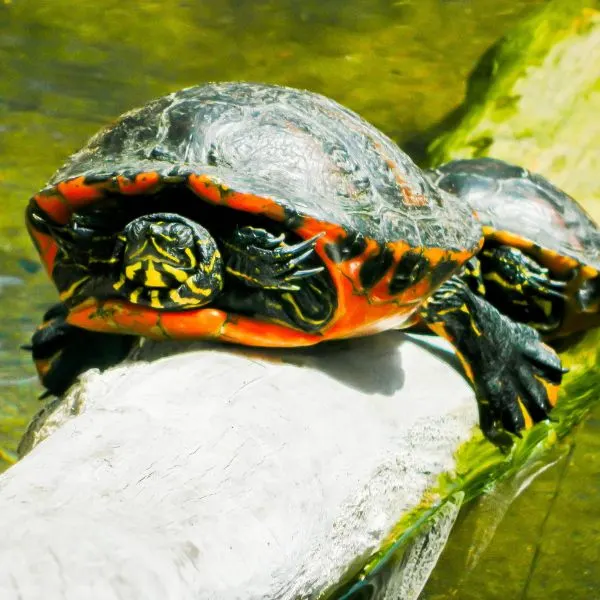
- Experience Level: Beginner to Intermediate
- Family: Emydidae
- Scientific Name: Pseudemys rubriventris
- Other Names: American red-bellied turtle
- Adult Size: Between 8 and 12 inches
- Life Span: Between 40 and 55 years
- Average Price Range: Between $30 and $170
- Conservation Status: Near threatened
Northern Red-bellied Cooters are large basking turtles that inhabit ponds, rivers, and other permanent bodies of water with slow currents and plenty of basking spots. They are identified by the bright orange or red plastron. They have red markings on the dark colored carapace that fade as they age.
Since these turtles spend so much time basking, they get very dark, nearly black on the upper shell and skin. This darkening makes them look like they either don’t have any distinguishing markings or are difficult to see.
Their native range often overlaps with Painted turtles, and indeed, they can often be seen basking with Painted turtles on fallen logs and outcroppings. This can cause difficulty in identification, especially since they will slip into the water whenever anyone gets close.
Red-bellied Cooters are omnivores but will consume more vegetation as they get older. Younger individuals feed more on protein sources such as mollusks, crayfish, tadpoles, insects, and worms.
Map Turtles in New Jersey
4. Northern Map Turtle
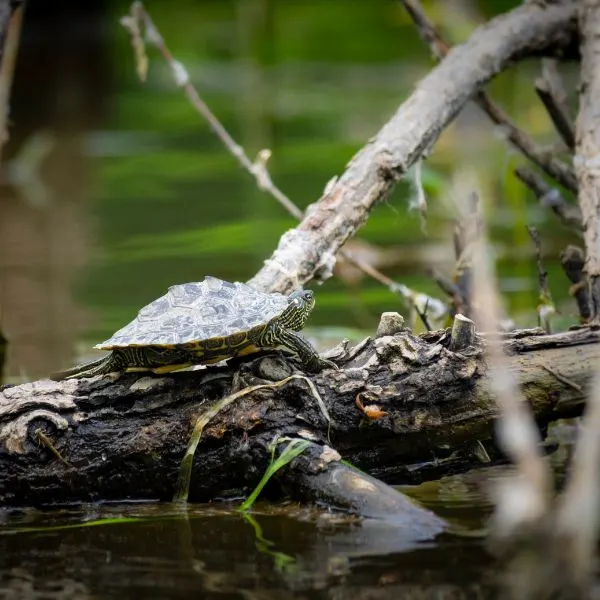
- Experience Level: Beginner
- Family: Emydidae
- Scientific Name: Graptemys geographica
- Other Name: Common map turtle
- Adult Size: Between 4 and 10 ½ inches
- Life Span: 15 to 20 years
- Average price range: Between $20 and $60
- Conservation Status: Least concern
Map turtles are very skittish and rarely leave the water except to bask and lay eggs, so it may be difficult to see these turtles in the wild. They do love to bask, but they will quickly run back to the water as the first sign of noise or movement.
When you are able to observe them you will notice a green, olive, or grey-green carapace with orange, or yellowish lines that resemble the contours of a map. They have yellow or white stripes on their exposed skin, and they have a pale yellow or cream colored patternless plastron.
You may also notice a ridge in the middle of the carapace and slight serrations at the back edge of the shell. One last distinguishing characteristic is the roundish or elongated spot behind the eyes.
You can find these turtles in large bodies of water including lakes, and wide rivers.
Here they feed on crustaceans, fish, mollusks, insects, and occasionally aquatic vegetation.
Mud Turtles in New Jersey
5. Eastern Mud Turtle

- Experience Level: Beginner
- Family: Kinosternidae
- Scientific Name: Kinosternon subrubrum
- Other Names: Common mud turtle
- Adult Size: 3 to 4 inches
- Life Span: 40 to 50 years
- Average Price Range: $20 – $100
- Conservation Status: Least concern
Mud turtles like slow-moving, muddy substrate waters with plenty of vegetation. Swamps, drainage ditches, bogs, ponds, and similar places may have these turtles in them. In New Jersey, the Mud turtle is found all over the southern half of the state, and in a few northern counties.
These little turtles have oval shaped, unpatterned shells. They are solid colored from dingy yellow to dark brown. Their skin is typically grey to dark brown with black mottling.
These turtles are equally at home in the water and out. They often leave the water to burrow in the mud or to find food to eat. In the winter they will leave the water and dig into the soft mud a few inches down and remain until it gets warm again.
Eastern Mud turtles are omnivores, but mainly eat mollusks and fish. Aquatic vegetation is also on the menu for these turtles as well.
Musk Turtles in New Jersey
6. Eastern Musk Turtle
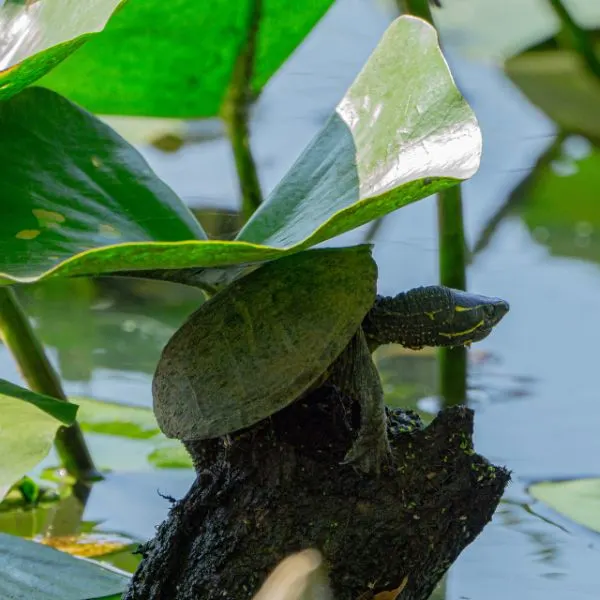
- Experience Level: Intermediate
- Family: Kinosternidae
- Scientific Name: Sternotherus odoratus
- Other Names: Common Musk turtle, Stinkpot
- Adult Size: 4 to 5 inches (10 to 12.5 cm)
- Life Span: 30 to 50 years
- Average Price Range: $30 to $120
- Conservation Status: Least concern
The Eastern Musk turtle looks similar to the Mud turtle we just went over. They both have oval, nearly egg-shaped shells, solid colored carapaces, and prefer the same water types. You can recognize the Eastern Musk turtle by the stripes running along the side of their heads.
Two yellow to white stripes start at the pointed snout and run over and under the eyes to the back of the head. They also have fleshy barbels on the chin and neck.
These turtles are nicknamed the “Stinkpot” because of the putrid smelling musk they can emit when they are frightened. Not only will they assault you with foul musk, but they will also try to bite if you try to handle them, so it’s probably best just to observe them, and not interfere with their wanderings.
The Common Musk turtle also has another trick up its shell, they can climb. When trees have low hanging limbs, the turtle will climb into the tree. They have been found up to 6 feet high, so be careful when walking along the water’s edge, you might get beaned by a falling Stinkpot.
These turtles are nocturnal hunters that feed on fish, amphibians, crustaceans, snails, insects, worms, and some vegetation.
Painted Turtles in New Jersey
7. Eastern Painted Turtle
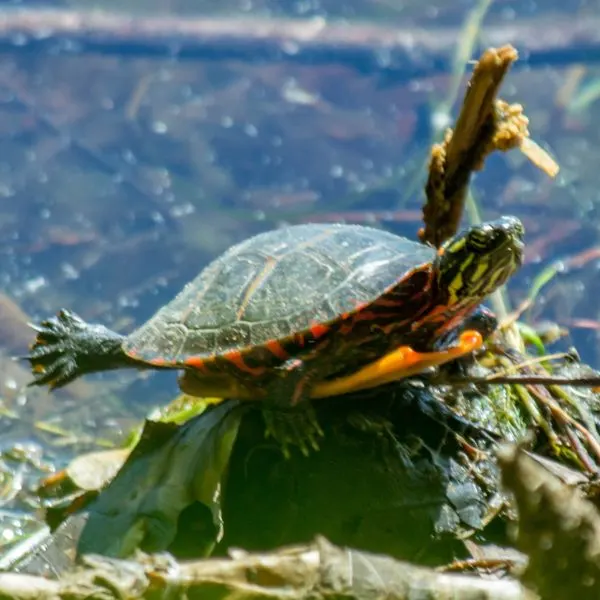
- Experience level: Beginner
- Family: Emydidae
- Scientific Name: Chrysemys picta
- Common Name: Painted Turtle
- Average Adult Size: 4 – 10 inches
- Life Span: 30 – 50 years
- Average Price Range: Between $30 to $150
- Conservation Status: Least Concern
Eastern Painted turtles are quite abundant and can be found across the state. They prefer shallow waters such as ponds and streams, but they can be found in nearly any permanent body of water.
You’ll recognize these medium-sized turtles by the yellow, orange, and red stripes found on the legs, neck, tail, and head. Their streamlined shell is dark brown to black with red and black patterns along the outer edge. The plastron is solid yellow to orange.
Often this turtle is confused with the Red-bellied cooter as they look similar from a distance.
If you can get close enough to see the carapace, you’ll notice the only patterns are the straight lines made from the rows of scutes, and the slight outline on them.
Eastern Painted turtles are omnivores that feed on plants, fish, fish carcasses, crustaceans, and insects.
Pond Sliders in New Jersey
8. Red Eared Slider
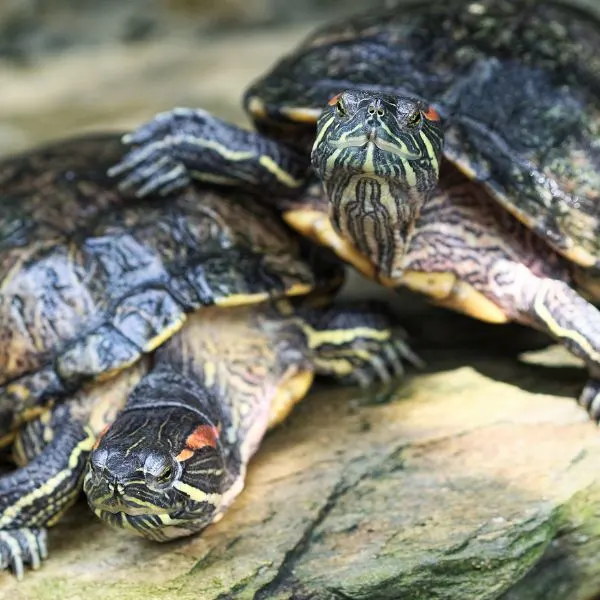
- Experience level: Beginner
- Family: Emydidae
- Scientific Name: Trachemys scripta elegans
- Common Name: Pond slider, Red-eared terrapin, Water slider
- Average Adult Size: 6 – 8 inches
- Life Span: 20 to 40 years
- Average Price Range: approximately $30 to $100
- Conservation Status: Least concern
The Red Eared Slider is an introduced species. Their native habitat does not run this far north, but they have shown that cold winters are not too harsh for them to survive. These turtles are extremely lively and cute when they are little, and they are quite popular.
People purchase them thinking it’s a small pet that doesn’t require much care. They soon find out that taking care of any type of turtle has a lot of requirements. Thinking they are saving the turtle, they release them into the wild, where they end up becoming a nuisance, and invasive species.
These turtles look similar to Painted turtles. Red Eared sliders have a pale yellowish plastron with black smudges, a decorative carapace that fades with age, and dark skin with yellow stripes. The tell-tale indication is the pair of red patches behind their eyes.
When these turtles are not basking in the sun, they are typically swimming in slow-moving waters and searching for food. They will eat nearly anything including fish, crustaceans, mollusks, carrion, flowers, plants, and seeds. They’re really not picky at all.
Snapping Turtles in New Jersey
9. Common Snapping Turtle

- Experience level: Intermediate to Expert
- Family: Chelydrida
- Scientific Name: Chelydra Serpentina
- Other Names: Snapping Turtle, Snapper, Eastern Snapping Turtle
- Average Adult Size: 8 to 20 inches
- Life Span: 30 – 50 years
- Average Price Range: Approximately $40 to $120
- Conservation Status: Least concern
Common Snapping turtles are the “bulldogs” of the turtle world. They have a broad-legged stance, and rounded muscular legs, and broad, sharp-beaked mouths. You’ll also see a ridged, long tail on these turtles.
The shell may have three small ridges, is solid and dark colored, and doesn’t cover the turtle very well. Their bumpy skin can be dingy yellow, to dark brown.
These turtles can be found in all types of water, from ponds to lakes, swamps, and even brackish water; though they can only tolerate salty water for a short period.
Snapping turtles like a muddy substrate because the older they get, the less active they become. Instead of actively hunting or basking, these turtles bury themselves in the mud and wait for food to swim near.
They spend so much time in the water that their shells are usually covered in mud and algae.
Though aggressive on land, they are very skittish and reclusive in the water.
Common Snappers are opportunistic omnivores. When anything edible swims near their hiding spot, they will strike out and gobble it up. Frogs, fish, amphibians, tadpoles, small turtles, crayfish, and even small waterfowl can be eaten by these turtles.
When meat sources aren’t abundant, the Common Snapper will eat vegetation.
Softshell Turtles in New Jersey
10. Spiny Softshell Turtle
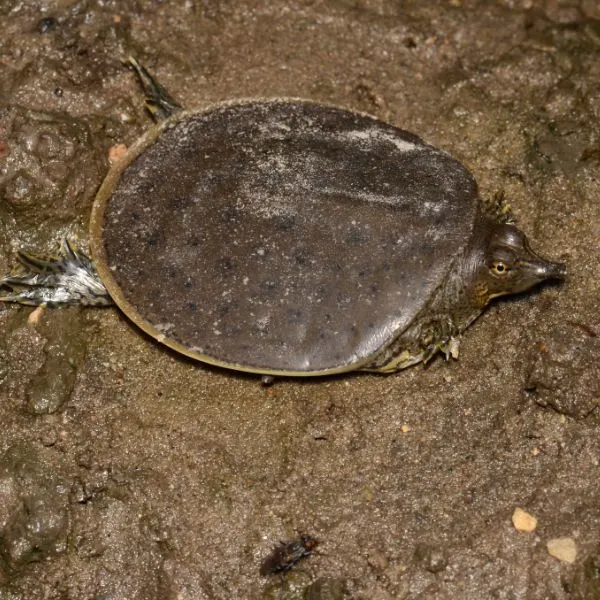
- Experience Level: Intermediate to Expert
- Family: Trionychidae
- Scientific Name: Apalone spinifera
- Other Names: N/A
- Adult Size: 5 to 9 ½ inches for males, 10 to 17 inches for females
- Life Span: Between 20 and 50 years
- Average Price Range: Between $20 and $120
- Conservation Status: Threatened in some areas
Another introduced species in New Jersey, the Eastern Spiny Softshell turtle likes to hang out in fast moving waters such as rivers and streams. They like to find places with sandy bottoms because they often bury themselves in the sand and ambush prey.
These turtles resemble puffy tortillas because they don’t have a hard, domed shell. Instead, they have a rubbery, skin covered carapace. It’s usually sandy brown, grey, or dark brown with darker spots and circles. The outer edge is lighter, and the bottom of the turtle can be pale yellow to white.
They have bumpy nodules on the front of their carapace, and a sandpaper feeling shell. They have a long, pig-like snout that helps them reach the surface for air without leaving the safety of the water.
Softshell turtles have very webbed front and back feet, are excellent swimmers, and are quite swift on land.
Females grow nearly twice as big as males, and their dark markings fade with age.
Spiny Softshell turtles are carnivorous. They feed on small aquatic organisms they can get down in a bite or two.
Spotted Turtles in New Jersey
11. Spotted Turtle

- Experience Level: Intermediate to Expert
- Family: Emydidae
- Scientific Name: Clemmys guttata
- Other Names: Polka-dot turtle, “Spotty”
- Adult Size: 4 to 5 inches
- Life Span: Males up to 65 years; females up to 110 years
- Average Price Range: $200 to $300
- Conservation Status: Endangered
Spotted turtles are small and hard to spot in the bogs, marshes, and wetlands they call home. When you do see them you’ll notice a black shell with bright yellow spots on the carapace. Individuals may have one or two spots, or they can be covered with them.
Their exposed skin is also black or dark brown with plenty of spots. The plastron is yellowish with black patches.
Spotty’s live in the water and on land, but they won’t travel far from the water.
Their numbers are in decline because of habitat loss and poaching for the pet trade. They are small, very cute turtles that are in high demand.
Spotted turtles are mostly carnivorous. They will eat insects, snails, crayfish, tadpoles, leeches, and the occasional fish, and worms. Sometimes they feed on water lily seeds and other vegetation.
Terrapins in New Jersey
12. Northern Diamondback Terrapin
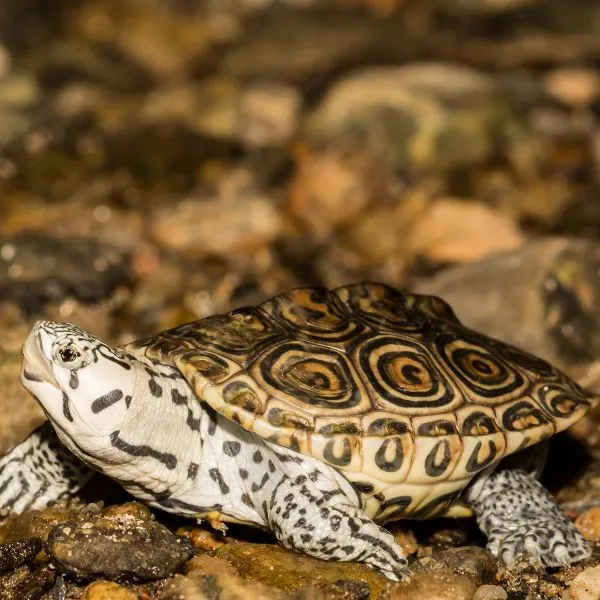
- Experience Level: Beginner to Intermediate
- Family: Emydidae
- Scientific Name: Malaclemys terrapin terrapin
- Other Names: Diamond-backed terrapin
- Adult Size: 4.5 to 9 inches (11.5 to 23 cm)
- Life Span: 25 to 40 years
- Average Price Range: $250 to $600
- Conservation Status: Special concern in Connecticut
Northern Diamondback Terrapins are the only species that can live completely in brackish waters. Other turtles can tolerate short stints in brackish waters, but they have to return to freshwater to survive.
These turtles are found along the coast in estuaries, tidal marshes, and other brackish environments. Sometimes they even swim out into the ocean but will return to their brackish environment.
Diamondback Terrapins drink water by opening their mouths on the land when it rains to drink in the raindrops, or they swim to the surface where freshwater gathers and they drink the water there.
As the name suggests, their carapace takes on a slight diamond shaped-wedge. The shell is grey to nearly black, and the scutes tend to have black rings or concentric swirls on them. Their skin is white, grey, or dark brown with black spots. Some males even have patterns on their faces that resemble mustaches.
Their favorite food is crabs, and they will sometimes follow these crustaceans into crab traps where they will drown. Crab fishermen are supposed to affix their traps with turtle escapes to prevent these accidental fatalities.
Aside from crabs, the Diamondback Terrapin will eat shrimp, small clams and mussels, and mollusks.
Wood Turtles in New Jersey
13. Wood Turtle
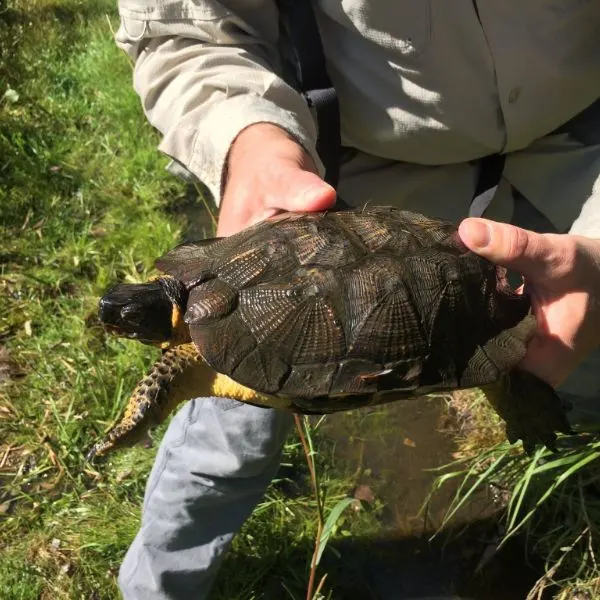
- Experience Level: Intermediate
- Family: Emydidae
- Scientific Name: Glyptemys insculpta
- Other Names: N/A
- Adult Size: 5.5 to 9 inches
- Life Span: 40 to 60 years
- Average Price Range: $250 to $500
- Conservation Status: Endangered
Wood turtles are an intelligent species that looks like they have their shells sculpted out of wood. Their carapace is golden to dark brown, has deep ridges like wood grain, and the scutes are slightly raised.
They have brownish skin and scales with various shades of red or orange, especially on the legs. They are a beautiful species, but these pretty creatures have brains as well. They can trick worms into coming out of the earth.
Wood turtles will stomp their feet and shells on the ground to imitate the sound of rain. Worms in the area think they are about to get flooded out and climb out of their safe burrows, only to be eaten by the crafty turtle.
You can find these turtles around woodlands with ponds, babbling brooks, and other slow current waters. Wood turtles are semi-aquatic and spend a lot of time exploring on the damp ground.
Wood turtles are omnivores that feed on berries, plants, insects, worms, caterpillars, fungi, snails, and small, unwary fish.
Sea Turtles in New Jersey
Sea turtles don’t nest on New Jersey coasts because the waters are too cold, but they can occasionally be seen near the shore as they search for food, or migrate to warmer waters.
14. Atlantic Green Sea Turtle
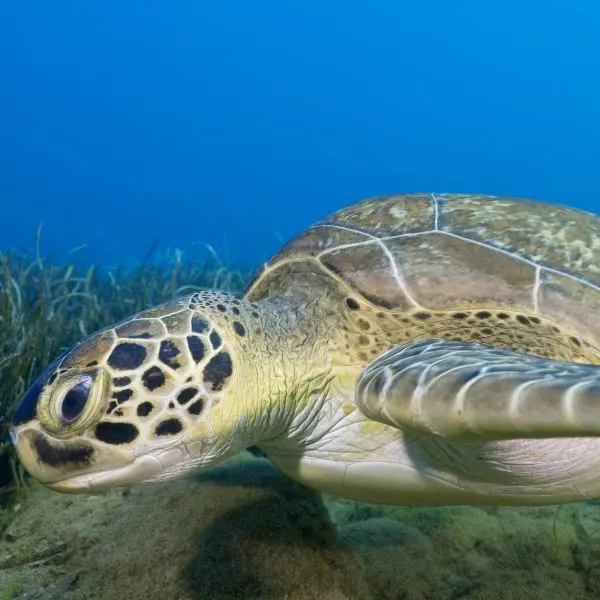
- Experience level: N/A, Illegal to own any sea turtle
- Family: Cheloniidae
- Scientific Name: Chelonia mydas
- Other Names: Green Sea Turtle
- Average Adult Size: 3 – 4 feet
- Life Span: 50 – 70 years
- Average Price Range: N/A
- Conservation Status: Endangered
Green Sea turtles get their name from the green fat inside their bodies. This coloration comes from the algae and grasses they eat. Adults are almost exclusively herbivores, but young turtles eat more meat such as shrimp, fish, and krill.
Green Sea turtles have large shells that are brown, green, olive, black, and yellow in color. Their scales are dark brown, black, or green and are outlined in white or yellowish color.
15. Hawksbill Sea Turtle
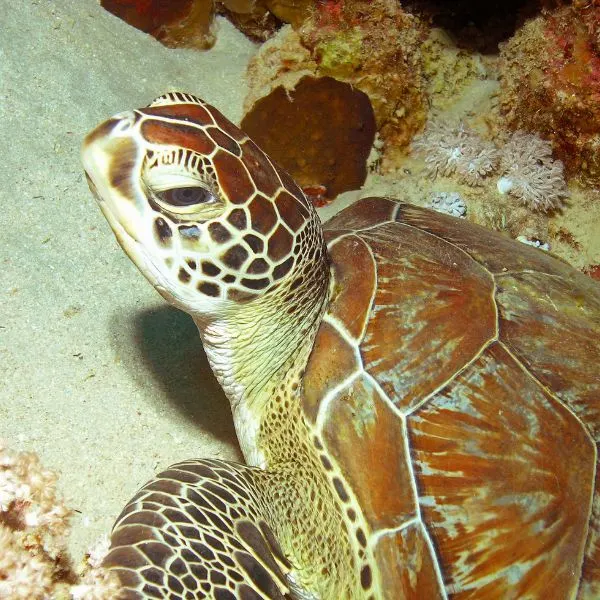
- Experience level: N/A, Illegal to own any sea turtle
- Family: Cheloniidae
- Scientific Name: Eretmochelys imbricata
- Other Names: Hawksbill
- Average Adult Size: 30 – 36 inches
- Life Span: 50 – 60 years
- Average Price Range: N/A
- Conservation Status: Critically endangered
Hawksbill Sea turtles are some of the most stunning looking turtles. They have a sharp, hawk-like beak they use to eat sea sponges. They have marbled looking, gorgeous shells that are sometimes harvested to make frivolous items such as lamps, guitar picks, combs, and other accessories.
While they are protected in the U.S. many other countries do not have such protection attached to these turtles.
16. Kemp’s Ridley Sea Turtle
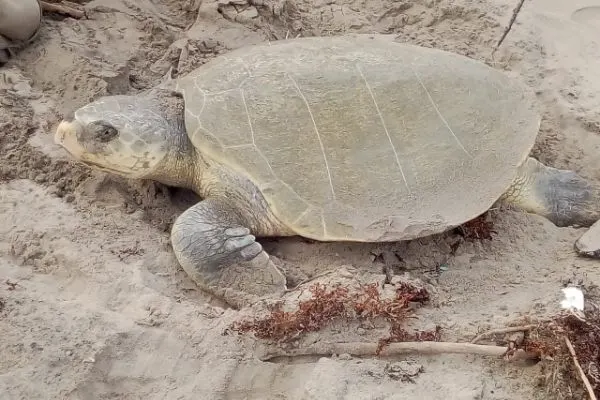
- Experience level: N/A, Illegal to own any sea turtle
- Family: Cheloniidae
- Scientific Name: Lepidochelys kempii
- Other Names: Atlantic Ridley, Tortuga Lora (Mexico)
- Average Adult Size: 24 – 27 inches
- Life Span: 30 years
- Average Price Range: N/A
- Conservation Status: Critically endangered
The smallest of all marine turtles, the Ridley sea turtle is the only turtle that lays its eggs during the daylight. They also practice something called arribada.
When it comes time for females to lay their eggs, hundreds will gather together near the nesting site, and they will all climb ashore and lay their eggs in sandy nests at the same time. It’s thought that this process protects the babies from predators.
Seagulls, crabs, small mammals, crows, ants, and large fish all feed on turtle eggs and babies when they hatch and try to escape to the water. It’s thought that only about 1 in a thousand sea turtle babies actually make it to adulthood.
17. Leatherback Sea Turtle
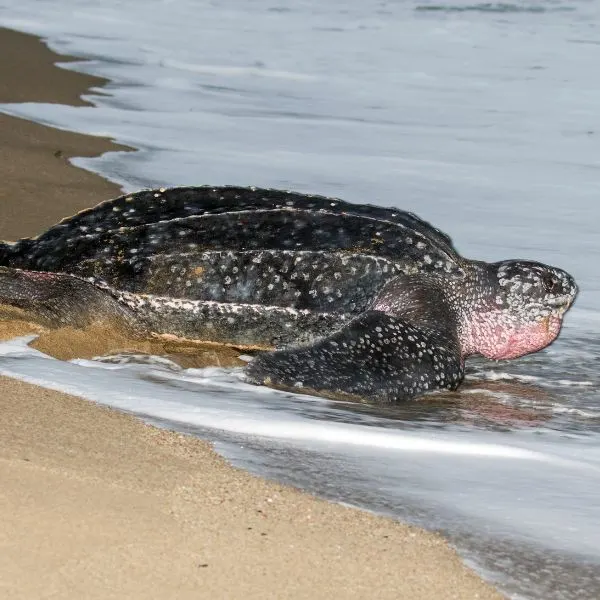
- Experience level: N/A, Illegal to own any sea turtle
- Family: Dermochelyidae
- Scientific Name: Dermochelys coriacea
- Other Names: Atlantic Leatherback, Leatherback
- Average Adult Size: 4 – 8 ft
- Life Span: 30 – 50 years
- Average Price Range: N/A
- Conservation Status: Endangered
Leatherback Sea turtles are the largest turtle in the world. They also have leathery backs instead of hard shells. This turtle can dive up to 4,000 feet deep and will travel over 10,000 miles during their yearly migration.
Aside from their massive size, you can identify them by their dark coloration, long, powerful flippers, and the ridges across their backs.
Leatherback Sea turtles feed on large jellyfish called lion’s mane jellies. They have to eat up to 500 of these jellyfish per day to keep up with their massive calorie needs.
18. Loggerhead Sea Turtle
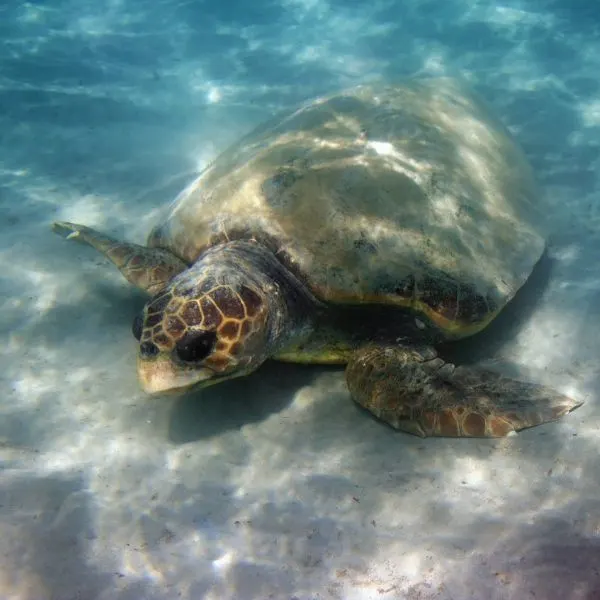
- Experience Level: N/A, Illegal to own any sea turtle
- Family: Cheloniidae
- Scientific Name: Caretta Caretta
- Other Names: Loggerhead
- Adult Size: 2.5 – 3.5 feet
- Life Span: 70 – 80 years
- Average Price Range: N/A
- Conservation Status: Endangered
Loggerhead Sea turtles are the largest hard-shelled turtles in the world. They have a slightly heart shaped shell, long flippers, and a large head in relation to their body.
The big head houses giant jaw muscles that are used to crack thick shells. Loggerhead turtles feed mostly on whelks, conches, and horseshoe crabs. These organisms have very hard shells the turtle has to get through in order to consume the soft insides.
They also often eat sea urchins, shrimp, crabs, and lobsters.
FAQs
Are turtles illegal in New Jersey?
According to New Jersey’s turtle laws, you can own any of the native turtles found in the state except for Bog turtles and of course Sea turtles. The trick is you can’t take them from the wild, and you can’t sell turtles in the state, so you’ll run into difficulty finding turtles for sale.
You also need a permit to own most turtle species. You’ll have to go across state lines or find a reputable breeder that will ship your new pet to you.
Wrapping up
This concludes our list of the 18 species of turtles you can find in and around New Jersey. The Garden State has a wide array of turtles from the brackish water loving Diamondback Terrapin, to the endangered Bog turtle. We also covered terrestrial turtles such as the Eastern Box turtle, semi-aquatic turtles like the Wood turtle, and the 5 Sea turtles you might find off the coast.
If you enjoyed this or other lists, please feel free to leave us a comment below. Share stories with other herping enthusiasts, tell us what you like about New Jersey turtles, or just say hi.
Other nearby states
- Turtles in Delaware
- Turtles in Maryland
- Turtles in New York
- Turtles in Pennsylvania
- Turtles in Virginia
